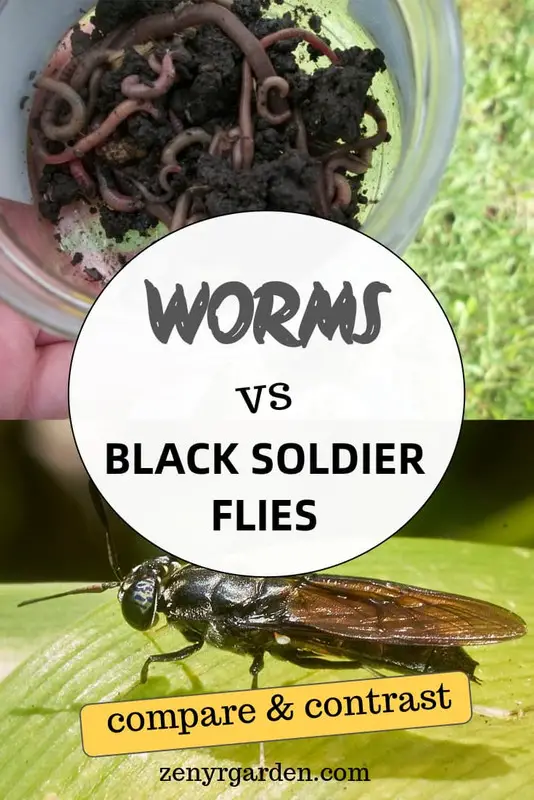Compost worms like red wigglers and black soldier flies do have something in common. They however are quite different on several aspects.
The good thing is, if we have both the worms and the BSF, we can integrate them so each can complement the other nicely in our gardening system.
Let's find out.
Worms & BSF Both Like Bokashi Bran
Compost worms and BSF both love the bokashi bran. In fact, fermented foods are a favorite on their diet.
Many have found that worms, when fed with bokashi, produce about 10 times faster than they normally would on other food scraps or kitchen waste. And the worms do produce more castings while enjoying their bokashi happy meal.
Part of the reason for this may be because bokashi or fermented foods are pre-digested by the other little microbes around it. Thus, making it easier for the worms and the larvae to eat.
As a matter of fact, worms don't have teeth. This is a little fun fact shared by AJ, a worm raising guy, which does leave us to question how do worms chew. For some people, they put sand in as grit for the worms to grind on food. But anyway, we digress.
Moving back to the fermented foods that we can use, because of the pre-digested nature of the foods, they do not rot or cause any stinky smell. This way, you won't be attracting any houseflies or molds to your worm bin or BSF bin.
Also, fermented foods last much longer than fresh or decaying ones. It also adds a great variety of good microbes for the wiggly youngsters.
Worms Like BSF Castings
After cleaning up a BSF cage or box, growers usually gather the BSF residue to feed to the worms. In the residue, there's often the undigested foods, the BSF exoskeleton and their poop.
Interestingly for some reason, worms love this stuff. People have found good results with this feed as they've seen their worms grow fast and strong while munching on BSF residue.
Possibly, this may be because there are some foods that the worms eat but the BSF say 'Nah, thanks'. Thus, leaving the worms with a treasure trove of yummy treat in the form of undigested foods in the BSF residue.
We don't know yet whether the other way around is true. That is, do BSF love worm castings? Maybe some tests can be set up to see the reactions. However, if you have these two together, then you can utilize the BSF castings to feed your worms for very cheap or for free.
Cardboard
Worms love cardboard or any fibrous cellulose-based stuff like tissue paper. Black soldier flies on the other hand are more 'meh' to this foodstuff.
Explaining this from the BSF point of view, it may be because there's not that many enzymes to digest long chains of sugar like cellulose inside the larvae gut.
The BSF don't do too well with lignin, a plant protein, either. So it may be better to leave this task for the worms.
Other Diet Differences
Because of this nature, we can see it leads to some more differences in the food choice between the two of them. While BSF do okay with fruits, they tend to grow better on higher-energy stuff like meat, fats or oil. Whereas for worms, they are crazy about fruits, especially watermelons and avocados.
In simple words:
What the worms don't eat, the BSF eat. What the BSF don't eat, the worms eat (usually).
From this we can:
Feed worms with lower-energy stemy woody stuff. Feed BSF with higher-energy protein, fats, meats.
| Worms like/BSF don't really like |
|---|
| grass |
| pine needles |
| wood chips |
| cow manure |
| cardboard |
| brocolli stem |
| BSF like/Worms don't really like |
|---|
| more meats/fish |
| chicken manure |
| pig manure |
| softer bones |
| milk/cheese |
BSF are more meaty/bony eaters (meat-lovers). Worms are more fruity/veggie lovers (vegan).
Food Input & Castings Yield
BSF are big eaters but produce very little castings. Worms, on the other hand, are more gentle eaters but produce a massive amount of castings.
On average, in 100lbs (45kg) of BSF larvae there may be about 5lbs (2kg) of undigested leftovers (including the BSF poop). The yield is about 5% because most of the good stuff are now converted and stored right inside the BSF body.
In contrast, roughly 11 lbs (5kg) of worm biomass may produce 2.2 lbs (1kg) of castings in 3 months. The yield is about 18% more or less depending on the worm and the weather.
Worms eat half their weight a day, while some like African Nightcrawlers can eat up to 1.5 - 2 times their body weight a day. So for a pound/a kilo of worms, you can feed them with half a pound/half a kilo to 2 lbs/kg of food and they'll be happy. Red worms can eat 1 lbs (450 gram) a week while big eaters like African Nightcrawlers can eat 1-3 lbs (450 gram - 1.3 kg) a week.
BSF, on the other hand, are voracious eaters. They eat like horses and can take in up to 5-10 times their body weight. This means, a pound/a kilo of BSF larvae can chew 5-10 lbs/kg of foods easily with zero complaints especially if it's something that they like.
You can read more at:
Share or pin this post!

Cover image source:

